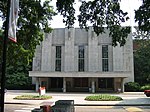North Carolina State University reactor program
North Carolina State University in 1950 founded the first university-based reactor program and Nuclear Engineering curriculum in the United States. The program continues in the early 21st century. That year, NC State College administrators approved construction of a reactor and the establishment of a collegiate nuclear engineering program. The first research reactor was completed in 1953; it was scaled up in 1957 and 1960 (referred to as R-1, R-2, and R-3). It was deactivated in 1973 to make way for the PULSTAR reactor. The old reactor has been decommissioned. The PULSTAR is used for a variety of purposes, including training and research. The reactor is located in Burlington Engineering Laboratories on NCSU's main campus. This facility was built to house the first reactor and then expanded and renamed when the PULSTAR was built. The current reactor is one of two PULSTAR reactors built, and the only one still in operation. The other reactor was a 2 MW reactor at the State University of New York at Buffalo. It went critical in 1964 and was decommissioned in 1994.
Excerpt from the Wikipedia article North Carolina State University reactor program (License: CC BY-SA 3.0, Authors).North Carolina State University reactor program
Stinson Drive, Raleigh West Raleigh
Geographical coordinates (GPS) Address Nearby Places Show on map
Geographical coordinates (GPS)
| Latitude | Longitude |
|---|---|
| N 35.785852417453 ° | E -78.668945249963 ° |
Address
Burlington Engineering Laboratories
Stinson Drive 2500
27695 Raleigh, West Raleigh
North Carolina, United States
Open on Google Maps







